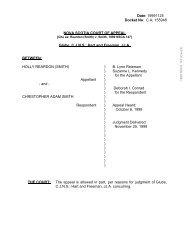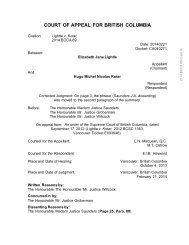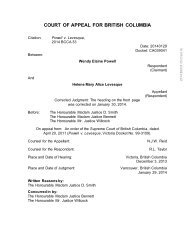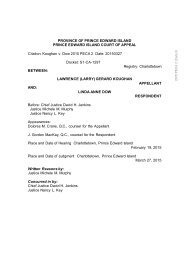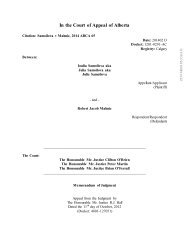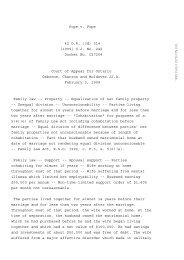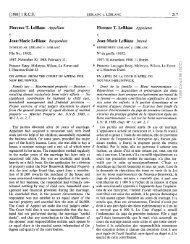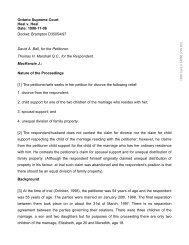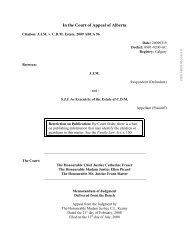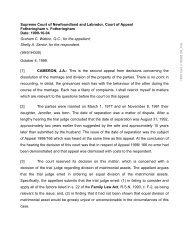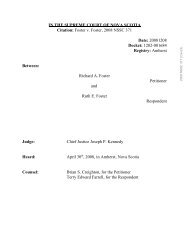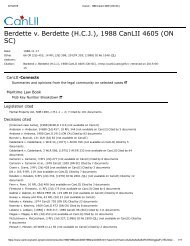Fotheringham v Fotheringham - 1999canlii18995 - Unconscionable.pdf
Fotheringham v Fotheringham - 1999canlii18995 - Unconscionable.pdf
Fotheringham v Fotheringham - 1999canlii18995 - Unconscionable.pdf
Create successful ePaper yourself
Turn your PDF publications into a flip-book with our unique Google optimized e-Paper software.
Supreme Court of Newfoundland and Labrador, Court of Appeal<br />
<strong>Fotheringham</strong> v. <strong>Fotheringham</strong><br />
Date: 1999-10-04<br />
Graham C. Watton, Q.C., for the appellant;<br />
Shelly A. Senior, for the respondent.<br />
(99/01H009)<br />
October 4, 1999.<br />
[1] CAMERON, J.A.: This is the second appeal from decisions concerning the<br />
dissolution of the marriage and division of the property of the parties. There is no point in<br />
recounting, in detail, the grievances each has with the behaviour of the other during the<br />
course of the marriage. Each has a litany of complaints. I shall restrict myself to matters<br />
which are relevant to the questions before the court on this appeal.<br />
1999 CanLII 18995 (NL CA)<br />
[2] The parties were married on March 1, 1977 and on November 8, 1981 their<br />
daughter, Jennifer, was born. The date of separation was a matter of dispute. After a<br />
lengthy hearing the trial judge concluded that the date of separation was August 31, 1992,<br />
approximately two years earlier than suggested by the wife and approximately 10 years<br />
later than submitted by the husband. The issue of the date of separation was the subject<br />
of Appeal 1998/166 which was heard at the same time as this appeal. At the conclusion of<br />
the hearing the decision of this court was that in respect of Appeal 1998/ 166 no error had<br />
been demonstrated and that appeal was dismissed with costs to the respondent.<br />
[3] The court reserved its decision on this matter, which is concerned with a<br />
decision of the trial judge regarding division of matrimonial assets. The appellant argues<br />
that the trial judge erred in ordering an equal division of the matrimonial assets.<br />
Specifically, the appellant submits that the trial judge erred: (1) in failing to consider and<br />
apply all of the factors listed in s. 22 of the Family Law Act, R.S.N. 1990, c. F-2, as being<br />
relevant to the issue; and, (2) in finding that it had not been shown that equal division of<br />
matrimonial asset would be grossly unjust or unconscionable in the circumstances of this<br />
case.
[4] Naturally enough, the trial judge did not turn his attention to the division of<br />
assets until after the date of separation had been assertained as that date is critical in<br />
deciding what assets are matrimonial assets. However, it seems that during the trial a<br />
question arose about whether some of the assets were in fact business assets, though the<br />
pleadings had not raised the issue. The trial judge, in the end, concluded that equal<br />
division should prevail but he ordered that the appellant could apply to have determined<br />
whether certain assets were business assets. This is important as, of course, under the<br />
Family Law Act business assets are excluded from the definition of matrimonial assets.<br />
[5] The issues raised on this appeal are: (1) Whether the trial judge erred in<br />
concluding, in principle, that equal division was appropriate; and, (2) whether the trial<br />
judge should have determined the characterization of the assets as matrimonial or<br />
business assets prior to deciding if there should be equal or unequal division.<br />
1999 CanLII 18995 (NL CA)<br />
Standard of Review<br />
[6] In Martin v. Martin (1998), 168 Nfld. & P.E.I.R. 181; 517 A.P.R. 181; 42<br />
R.F.L.(4th) 251, at para. 5, I summarized the standard of review applicable in family law<br />
cases as follows:<br />
"... a trial judge's decision should not be interfered with absent an error in principle, a<br />
failure to consider all relevant factors, a consideration of an irrelevant factor or a lack<br />
of factual support for the judgment. ... Matters such as custody, support, and<br />
matrimonial property generally require the trial judge to weigh and balance many<br />
relevant factors and, as Justice Kerans suggests in Standards of Review<br />
Employed by Appellate Courts (1994), 'the inclination of the reviewing courts has<br />
always been to govern with a light hand.'"<br />
Position of the Appellant<br />
[7] Section 22 of the Family Law Act, which governs unequal division, states:<br />
"22. The court may make a division of matrimonial assets that is not equal where the<br />
court is satisfied that a division of these assets in equal shares would be grossly<br />
unjust or unconscionable taking into account the following factors:<br />
(a) the income, earning capacity, property and other financial resources that each<br />
of the spouses has or is likely to have in the foreseeable future;
(b) the financial needs, obligations and responsibilities that each of the spouses<br />
has or is likely to have in the foreseeable future;<br />
(c) the standard of living enjoyed by the spouses before the breakdown of the<br />
marriage;<br />
(d) the age of each party;<br />
(e) the duration of the marriage;<br />
(f) a physical or mental disability of either of the spouses;<br />
(g) the contributions made by each of the spouses to the welfare of the family,<br />
including a contribution made by a spouse in looking after the matrimonial home<br />
or caring for the family;<br />
(h) the loss of a potential benefit to a spouse by reason of a dissolution or<br />
annulment of the marriage;<br />
(i) the unreasonable impoverishment or dissipation of matrimonial assets by<br />
either of the spouses;<br />
(j) the length of time that the spouses have lived separate and apart from each<br />
other during the marriage; or<br />
(k) the date of acquisition of each matrimonial asset."<br />
1999 CanLII 18995 (NL CA)<br />
[8] The decision of the trial judge indicates that the husband argued, in particular,<br />
paras. (g) and (i) as a basis for unequal division [see footnote 1]. Counsel for the appellant<br />
submits that the trial judge erred in failing to consider all of the relevant factors in s. 22,<br />
though he himself emphasized (g), (i), and (j) in his submissions to this court. In summary,<br />
the appellant contends that the trial judge erred:<br />
“1. In finding the parties' marriage to be a 'normal traditional marriage'; rather, the<br />
appellant argues, the parties 'lived separate and apart' as contemplated by s. 22(j)<br />
when the husband was away from the matrimonial home at River of Ponds;<br />
“2. In failing to find the wife made little contribution to child care, no contribution to<br />
household management and no financial contribution (i.e. - failed to fulfill the<br />
traditional homemaker role), specifically in ignoring the evidence of the couples'<br />
daughter, Jennifer, of Pearl Hynes, the woman with whom the appellant was living at<br />
the time of trial, and the appellant regarding the respondent's shortcomings and<br />
improperly inferring that because she had primary and sole responsibility for raising<br />
Jennifer the respondent did so properly; and<br />
“3. In ignoring evidence of unreasonable impoverishment and dissipation of<br />
matrimonial assets by the respondent, specifically that the trial judge failed to<br />
consider the monies that the appellant paid to the respondent throughout the years,<br />
the fact that there was no mortgage on the matrimonial home, no loan payments to<br />
be made, and no car payments to be made.”
Background<br />
[9] The trial judge summarized the history of the relationship between the parties in<br />
his decision respecting the date of separation. What follows is largely taken from that<br />
decision.<br />
[10] The respondent grew up in River of Ponds on the Northern Peninsula, the<br />
appellant in Scotland. They met in Toronto in 1973 and began living together in 1974. The<br />
respondent had a child, Jordana, born January 1, 1972 of an earlier relationship.<br />
[11] The appellant had trained in Scotland as a high-voltage cable splicer, a highly<br />
specialized trade. From the time the parties met until the divorce, he worked on projects in<br />
various parts of Canada, the United States, in Egypt and elsewhere in the Middle East,<br />
and in Central and South America. The respondent, with the except of two short periods of<br />
time, did not work outside the home after she began living with the appellant.<br />
1999 CanLII 18995 (NL CA)<br />
[12] At first, the respondent travelled with the appellant wherever he went but when<br />
Jordana began school, they decided to establish a permanent residence in River of<br />
Ponds. In 1981, the year Jennifer was born, they bought a house. The marriage was a<br />
troubled one. Each party complains about the other's behaviour. There were extra-marital<br />
affairs. At times when he was away from River of Ponds the appellant lived with other<br />
women. For example, during the respondent's pregnancy the appellant was living in<br />
Edmonton with the respondent's 19 year old cousin. When Jennifer was born prematurely<br />
and the respondent was discovered to have uterine cancer and needed help, that cousin,<br />
on the appellant's suggestion, moved into the parties' house until the respondent became<br />
suspicious and told her to leave. Generally, when not working elsewhere the appellant<br />
returned to River of Ponds and, while there, resided with the respondent and their<br />
daughter. On occasion the respondent and their daughter travelled to wherever the<br />
appellant was working, and on one occasion to Scotland, to visit with him.<br />
[13] The appellant supported his family during this time. In 1986 the appellant<br />
purchased a motor vehicle and about the same time the respondent obtained her driver's<br />
licence. She had unrestricted use of that car and other vehicles which replaced it over the
years. The appellant told the trial judge that there was a row over money during his visit at<br />
Christmas 1986 because the respondent had spent $24,000 between April and December<br />
and from that point on the appellant provided the respondent with a monthly amount of<br />
$1,500 which was reduced to $1,200 when Jordana left home in 1992.<br />
[14] In 1995 the appellant transferred virtually all of his savings and investments,<br />
nearly $360,000, to the name of Pearl Hynes.<br />
Approach Dictated by the Family Law Act<br />
[15] As s. 19 of the Family Law Act demonstrates, the general philosophy reflected<br />
in the Act is the recognition that both parties share the responsibilities for child care,<br />
household management and financial support of the family, that those responsibilities may<br />
be met in different ways, and that as a general rule each spouse is entitled, on marriage<br />
breakdown, to an equal division of the matrimonial assets acquired during the course of<br />
the marriage. There are numerous cases which have emphasized that the party seeking<br />
unequal division has a heavy onus to discharge. Justice Marshall, of this court, in Franey<br />
v. Franey (1997), 148 Nfld. & P.E.I.R. 181; 464 A.P.R. 181, at p. 186 described the<br />
condition to be established for unequal division as "flagrant unfairness." Others have said<br />
that "unconscionable" is equated with "shocking", that it requires conditions or<br />
circumstances which shake the conscience of the court. (See, for example, Belman v.<br />
Belman (1995), 26 O.R.(3d) 56.)<br />
1999 CanLII 18995 (NL CA)<br />
Periods of Time Living Separate and Apart During the Marriage<br />
[16] The words "separate and apart" are also used in the Divorce Act where to<br />
establish breakdown of a marriage the parties may prove that they "have lived separate<br />
and apart for at least one year immediately preceding the divorce proceeding ... ." The<br />
choice of the phrase "separate and apart" in the Family Law Act was no doubt deliberate,<br />
since actions under the two Acts are so often taken at the same time. It is therefore<br />
reasonable to interpret the phrase in the same way. (See: Wood v. Wood (1981), 23<br />
R.F.L.(2d) 77 (Man. C.A.)) The words "living separate and apart" require proof of an<br />
"animus separandi" in addition to the factum of separation. (See: Shorten v. Shorten
(1985), 65 N.B.R.(2d) 429; 167 A.P.R. 429 and Rushton v. Rushton (1968), 1 R.F.L. 215<br />
(B.C.S.C.)) In Rushton, a divorce action, Mclntyre, J., said:<br />
"The words 'separate and apart' are disjunctive. They mean, in my view, that there<br />
must be a withdrawal from the matrimonial obligation with the intent of destroying the<br />
matrimonial consortium, as well as physical separation. The two conditions must be<br />
met."<br />
Section 22(j) then is directed to any periods during the marriage when the parties might<br />
have separated with the intent of destroying the consortium.<br />
[17] It is clear from the evidence that because of his work, the appellant spent a<br />
great deal of time away from the family home in River of Ponds. However, this is not the<br />
type of separation which is intended to be a factor considered for unequal division. The<br />
trial judge recognized that in Newfoundland it is not unusual for one member of the family,<br />
usually the husband, to leave home and travel to other parts of the province, country or<br />
the world in order to obtain employment. Many successful, happy families follow such<br />
patterns with the husband "living" in the same household as the rest of the family for only<br />
short periods during the year. This pattern is common, for example, when a husband<br />
works on boats on the Great Lakes, or in construction camps in Labrador or northern<br />
Canada or, like the appellant here, holds a rare skill which might be in demand anywhere<br />
in the world. A similar pattern might be seen with servicemen who take overseas postings<br />
away from their families for extended periods of time.<br />
1999 CanLII 18995 (NL CA)<br />
[18] There is little doubt that the parties' marriage was an unhappy one, but such<br />
subjective considerations are not part of the factors under s. 22. There was evidence upon<br />
which the trial judge could make the findings he did. The onus was upon the appellant to<br />
prove, on the balance of probabilities, that both conditions of "separate and apart" were<br />
met. He failed to do so. There is no basis upon which to disturb the findings of the trial<br />
judge.<br />
The Contribution of the Respondent<br />
[19] Under this heading, in effect, the appellant argues that this was not a traditional<br />
marriage, albeit, the husband worked outside the home and the wife remained at home
with the children. The appellant submits that the wife did not perform any role, she was not<br />
contributing financially, she was not caring for the children and she was not managing the<br />
household. In short, the submission is that she contributed so little to the marriage that<br />
equal division would be grossly unjust or unconscionable.<br />
[20] As an adjunct to this submission, the appellant maintains that the trial judge<br />
failed to consider the evidence of the parties' daughter Jennifer, as well as the evidence of<br />
Pearl Hynes and the appellant himself. (Jennifer lived with her mother from her birth to<br />
May 1991, when she began living with her father. Subsequently she boarded with a family<br />
in River of Ponds where she was completing high school.)<br />
1999 CanLII 18995 (NL CA)<br />
[21] It is true that the trial judge in his decision did not summarize the evidence of<br />
Jennifer. However, he specifically refers to Jennifer's evidence in the context of his<br />
decision on this submission, acknowledging, by implication, its negative content. It is clear,<br />
therefore, that in considering the appellant's argument and weighing the evidence,<br />
Jennifer's evidence was considered though obviously not given the weight the appellant<br />
wished it to have. The trial judge concluded that the respondent had, with little help from<br />
the appellant, taken on and discharged the duty of caring for the children. In the process,<br />
he noted that the respondent had some shortcomings. However, it must also be<br />
underlined that there were positive statements about the respondent from other witnesses.<br />
Dissipation of Assets<br />
[22] The appellant argues that the respondent unreasonably impoverished or<br />
dissipated matrimonial assets. This is not supported by the evidence. Black's Law<br />
Dictionary defined "dissipate" as "to destroy or waste, as to expend funds foolishly." It is<br />
clear that generally speaking the appellant controlled the funds. In later years the amount<br />
given to the respondent to support herself and the children was precisely determined by<br />
the appellant. The amount provided was modest. I fail to see how the fact that the<br />
respondent had exclusive use of the family home and car for most of the year can<br />
demonstrate either dissipation or impoverishment of matrimonial assets on the part of the<br />
respondent. Normal use of an asset cannot be said to be dissipation of that asset. The<br />
appellant complained, in particular, about the respondent having spent $24,000 in
approximately 9 months in 1986, six years before they separated. (It was after this that the<br />
appellant sent only a specified amount to the respondent for her support and that of the<br />
children.) To place the amount in context, in the years from 1984 to 1989, the appellant's<br />
annual income, according to his income tax returns, ranged from a low of $80,149 to a<br />
high of $138,917. There is no pattern of waste, nor is the expenditure of $24,000 for the<br />
support of three persons during a period of 9 months proof of dissipation. I am confident<br />
that during every marriage one spouse purchases items which the other sees as wasteful.<br />
The test required by the Act is not whether the appellant approved of the respondent's<br />
management of money. The question is whether in the circumstances of the parties the<br />
questioned expenditures demonstrate that degree of wastefulness so as to meet the high<br />
test of the Act. That is not present in this case.<br />
1999 CanLII 18995 (NL CA)<br />
Other Factors in s. 22<br />
[23] As noted above, the onus is upon the appellant to prove that equal division<br />
would be grossly unjust or unconscionable. I would expect that where there is an arguable<br />
case based on the evidence related to the factors listed in s. 22, counsel for the appellant<br />
would point out both the evidence and the factors to which the evidence relates. It is clear<br />
that in this case the submissions of the appellant were based not on all the factors listed in<br />
s. 22 but only on those which have been dealt with on this appeal. The Family Law Act<br />
does not require that all the factors in s. 22 be considered in every case. This is not akin to<br />
s. 31 of the Children's Law Act, R.S.N. 1990, c. C-13, where a court is directed to<br />
consider a number of factors in deciding issues of custody of or access to a child. Here<br />
the onus is upon the party seeking unequal division to establish that any one or more of<br />
the circumstances enumerated in s. 22 of the Family Law Act demands such an order. In<br />
the absence of such an application the court is entitled to proceed on the basis that equal<br />
division is proper.<br />
[24] As noted above, this case proceeded in a somewhat unusual way, no doubt<br />
because of the stark difference between the parties as to the date of separation and the<br />
relevance of that issue to the other matters to be determined. In the normal course of<br />
events I would expect that prior to a consideration of whether there should be unequal<br />
division of matrimonial assets there would be a determination of what assets comprise the
matrimonial assets and, further, if there are business assets, whether the other spouse<br />
has made a contribution to acquisition, management, maintenance, operation or<br />
improvement of the business asset, thereby entitling him or her to an order under s. 29 of<br />
the Act. Since the financial resources of the parties in the future is a factor for<br />
consideration under s. 22(a) and (b) the elimination of an asset from the pool of<br />
matrimonial assets could have an impact on the determination under s. 22. In this case,<br />
however, when the matter was raised with counsel for the respondent, she indicated that<br />
her client was prepared to proceed with the appeal, accepting that the determination had<br />
been made on the principle of unequal division and accepting the consequences if some<br />
of the assets under consideration were held not to be matrimonial assets. In short, the<br />
respondent was prepared to take the chance that there were no business assets or, if<br />
there were, there would be little impact on the final division. In the circumstances,<br />
therefore, the failure to determine whether there were business assets is not sufficient to<br />
disturb the finding of the trial judge.<br />
1999 CanLII 18995 (NL CA)<br />
[25] For the reasons noted the appeal is denied with costs to the respondent.<br />
Appeal dismissed.<br />
Footnotes<br />
1. In the defence, reference is made to s. 22(a), (b), (e), (g), (i), (j) and (k).



